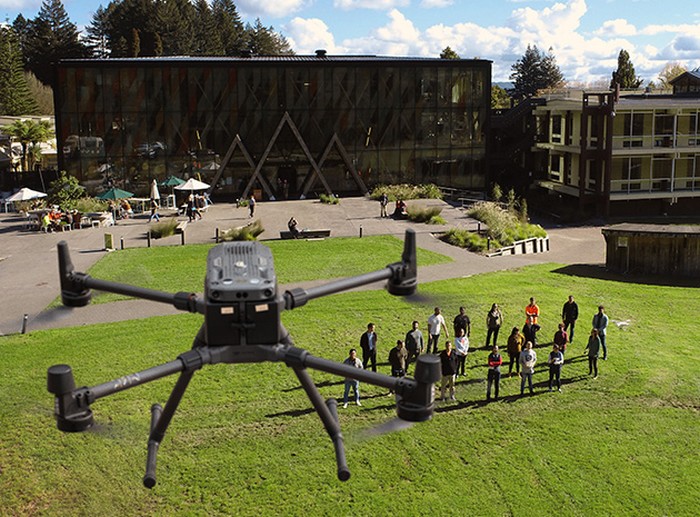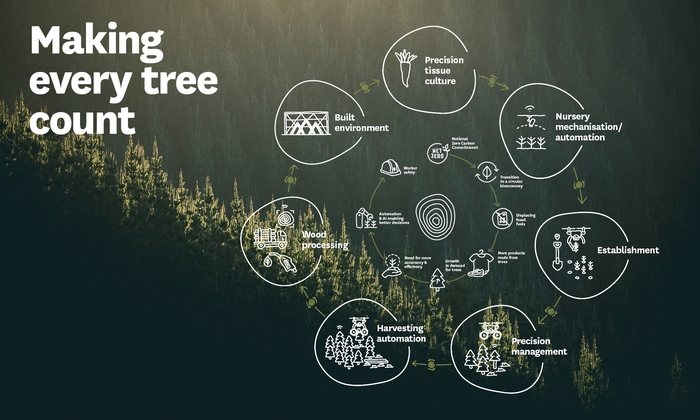Collective data driving forestry’s transformation

Precision forestry is helping forest owners and managers to realise new value across the supply chain.
If the Forestry and Wood Processing Industry Transformation Plan (ITP) is a roadmap for the future of New Zealand’s forestry sector, then precision forestry must be the turbo engine under the hood of the most competitive vehicles lining up at the start of the journey.
The plan, unveiled at Fieldays in November last year, sets out actions to increase New Zealand’s onshore wood processing capacity and capability, maximising the value of wood and supporting the development of new industries, products, and markets – both domestic and international.
In 2021, the sector contributed $6.7 billion in export earnings, employing more than 35,000 people. The ITP’s goal is to grow the sector and see New Zealand become a world-leading producer and exporter of high-value wood-fibre products.
How fast New Zealand can achieve all this will depend on how quickly the sector and its workforce can embrace research, innovation and new smart technologies.
Following agriculture’s lead, even if we took a conservative 5% annual increase in productivity, based on current sector revenue, that would translate to revenue growth of $316 million per year for the New Zealand forestry sector. - Claire Stewart
Making informed decisions using data
Investment in forest technology is already super charging New Zealand’s forestry sector by enabling the workforce to create higher-value products more efficiently. Precision silviculture is advancing at pace, and the tools available to foresters is arming them with more information for decision-making than ever before.
With the sector hungry for ways to gain a competitive edge, it was no surprise that an event devoted to forestry technology attracted a record number of participants just two weeks before the ITP was launched. The ForestTECH two-day conference in Rotorua brought together forest managers, technology providers and experts in the growing field of remote sensing and geospatial mapping from across Australasia.
During the conference, autonomous systems scientist Robin Hartley shared insights from Scion’s operational trials using remote sensing, spray UAVs and nutrient modelling, and participants heard from Scion principal scientist Dr Brian Richardson, who is heading Forest Growers Research’s $25.5 million, seven-year Precision Silviculture Programme.
The Government’s backing of the programme, with $10.2 million from the Ministry for Primary Industries’ Sustainable Food and Fibre Futures fund, shows it has confidence in the latest technology to create new value from planted forests and make highly manual and labour-intensive tasks more manageable.
The programme is focused on integrating mechanisation, automation, digital technology and robotics in the areas of planting, pruning and thinning, as well as creating efficiencies in the nursery where seedlings start their journey through the value chain.
In announcing the programme in May last year, Agriculture Minister Damien O’Connor said the timing was right and emphasised how much the sector had to gain for the investment.
“A large number of forests planted in the 1990s are due for harvesting in the mid- 2020s, so it’s an ideal time for this overhaul.
“The programme has the potential to deliver $530 million of value to the plantation forestry sector and $190 million worth of innovative technology sales until 2035. Other benefits will be an improved pruned log supply for domestic wood processors, and use of the technology in indigenous forest establishment.”
Scion portfolio leader for New Value from a Digital Forest and Wood Sector Claire Stewart is equally passionate about the ability for precision forestry to deliver at scale and increase productivity for the sector.
She delivered the keynote address at ForestTECH, stressing how vital it is for the sector to keep evolving using data collectively as the means to drive efficiencies.
“The value that’s created in businesses that are valuing their data is considerable. In the future, and as we come under greater regulation for environment impact, we need to consider how we create new value. A data-driven, optimised system is the place to invest.”
She says the agriculture sector has seen productivity gains of between 5% and 25% each year after adopting smart technologies.
“Following agriculture’s lead, even if we took a conservative 5% annual increase in productivity, based on current sector revenue, that would translate to revenue growth of $316 million per year for the New Zealand forestry sector.”

Extracting value through the life cycle of a tree
The demand for more high-value products from trees, coupled with the growth of carbon farming through incentives, is driving demand for more trees in the ground, especially in more marginal and harder to reach locations.
Scion and Hawke’s Bay forestry company Pan Pac Forest Products have been testing a range of precision forestry technologies to optimise their forestry management operations. From using remotely sensed data to predict the optimal planting locations for a radiata pine stand, to trialling a large model UAV for precision aerial applications of herbicide, Pan Pac is among a growing number of companies turning to technology to solve labour challenges or help foresters better understand tree and soil health, their crops’ nutritional needs and growth rates.
For Stewart, however, there is exponential value to be unlocked right through the life cycle of a tree, which she says is pulsing with data, starting with its genetics.
“In the lab, we can apply advanced tissue culture techniques to multiply our best trees by the tens of thousands and use genetic preselection to ensure they have the greatest tolerance to future adverse conditions, such as drought and disease.
“We can also use artificial intelligence in the lab for monitoring of mature somatic embryos to predict their germination success.”
AI is also being applied to the process of grading seedlings to maximise quality control. Scion has partnered with Contempo Lab under the Precision Silviculture Programme to build a prototype AI system for seedling grading that will accept or reject seedlings based on client specifications.
Contempo Lab chief executive Dr Brian Russell says AI decision support systems are sufficiently mature to enable teams to grade seedlings in real time, using manual sorting expertise at scale.
“This should allow us to individually sort and store every tree at the start of its data lifetime, leading to healthier forests now and more understanding for the next generation of forests.”
PF Olsen, a significant supplier of both seed and seedlings to the New Zealand forest industry, is also investing in the latest UAV and AI technologies to detect and quantify a wide range of growth indicators to increase nursery profitability.
The technology includes measuring seed germination rates when seedlings reach 5cm in height to detect plant stress. Business improvement manager Hamish Macpherson says that in the future, the data being collected at an individual seedling level will not only benefit nursery operations but will also improve treestock quality for forest owners.
“It will also enable the creation of traceability systems to potentially track seedlings from our nursery through to the forest and beyond.”
Deploying young trees in the market at scale, applying precision management technologies as they grow, and using data to inform harvesting decisions for wood processing to generate timber optimised for building are all areas where precision forestry can add value, Stewart says.
“We must make every tree count using smart technology. We have the ability to connect genetics, environment, growth, management, performance into the built environment and back again. An intentional focus on connecting these steps and the data that flows within them has the potential to deliver significant new value for the forestry sector.”

